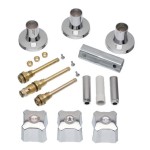Essential Aspects of Average Bathtub Size
Bathtubs are an essential component of any bathroom, providing a relaxing and rejuvenating way to unwind and cleanse. Choosing the right bathtub size is crucial to ensure comfort, functionality, and aesthetic appeal. This article delves into the various aspects of average bathtub size, providing valuable insights for homeowners and bathroom designers.
Standard Bathtub Dimensions
Standard bathtubs typically range in size from 5 feet to 6 feet in length, and 28 to 32 inches in width. These dimensions provide a comfortable bathing experience for most individuals and fit well in most bathroom layouts. However, larger or smaller bathtubs may be necessary for specific needs or spatial constraints.
Factors Influencing Size Selection
Several factors influence the ideal bathtub size for a particular bathroom. These include:
- Bathroom space: The size of the bathroom will determine the maximum bathtub size that can be accommodated.
- User height and体型: Taller or larger individuals may require a longer and wider bathtub.
- Tub style: Different bathtub styles, such as corner tubs or freestanding tubs, have varying dimensions.
- Accessibility needs: Individuals with mobility issues may require a bathtub with a lower height or a walk-in design.
- Aesthetic preferences: Personal preferences and the overall design scheme of the bathroom can also influence size selection.
Common Bathtub Sizes
In addition to standard sizes, bathtubs come in a range of other dimensions to meet specific requirements. Common sizes include:
- Compact bathtubs: These bathtubs are ideal for small bathrooms, measuring around 48 to 54 inches in length and 24 to 28 inches in width.
- Soaking tubs: Designed for deep, relaxing baths, soaking tubs are typically larger, ranging from 6 feet to 7 feet in length and 36 to 42 inches in width.
- Corner tubs: These space-saving bathtubs fit snugly into corners, with dimensions varying depending on the specific design.
- Freestanding tubs: Freestanding tubs offer a luxurious and modern aesthetic, and come in various sizes and shapes.
Depth and Shape Considerations
Besides length and width, the depth and shape of the bathtub are also important considerations. Standard bathtub depths range from 14 to 18 inches. Deeper bathtubs provide a more immersive bathing experience, while shallower bathtubs are easier to get in and out of. The shape of the bathtub can also impact comfort and space utilization. Oval, rectangular, and round bathtubs are common shapes, with each offering its own unique aesthetic appeal.
Conclusion
Choosing the right bathtub size requires careful consideration of various factors, including bathroom space, user needs, tub style, accessibility, and aesthetic preferences. By understanding the average bathtub size and the available options, homeowners and bathroom designers can select a bathtub that provides optimal comfort, functionality, and visual appeal.

Standard Bathtub Sizes 2024 Guide Modernize

Standard Bath Size Length Width Dimensions

What Size Is A Small Bath Ideal Baths For Bathrooms

Bathtub Dimensions In Feet All You Need To Know

What Is The Average Bathroom Size For Standard And Master

Bathtub Sizes Standard Tub Size Guide

Mobile Home Bathroom Guide Mhl

Standard Bath Sizes Bella Bathrooms Blog

Bathtubs Choosing The Perfect Bathroom Tub

Our Favorite Bath Trays And Accessories Reviews By Wirecutter
Related Posts








